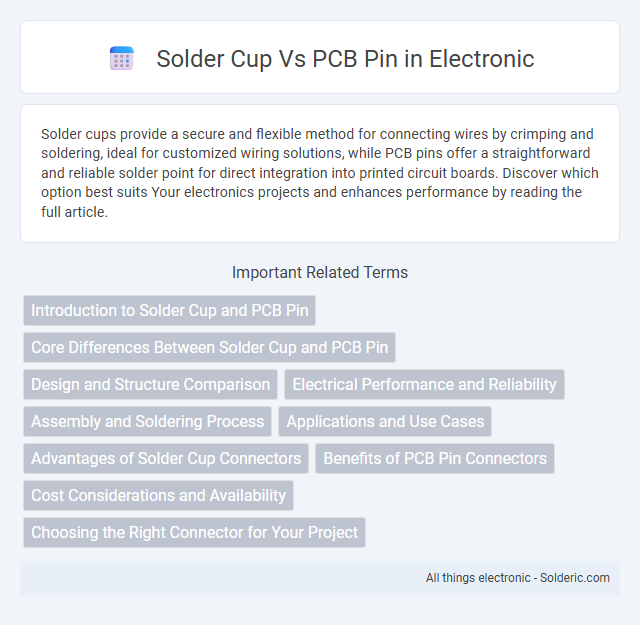Solder cups provide a secure and flexible method for connecting wires by crimping and soldering, ideal for customized wiring solutions, while PCB pins offer a straightforward and reliable solder point for direct integration into printed circuit boards. Discover which option best suits Your electronics projects and enhances performance by reading the full article.
Comparison Table
| Feature | Solder Cup | PCB Pin |
|---|---|---|
| Definition | Connector end with a cup-shaped cavity for soldering wires directly | Pin protruding from PCB used for direct insertion or soldering |
| Primary Use | Wire-to-connector soldering | Connector-to-PCB electrical connections |
| Connection Method | Soldering wires inside the cup | Inserted into PCB holes or surface-mounted and soldered |
| Mechanical Strength | Moderate; depends on quality of solder joint | High; securely fixed to PCB |
| Reworkability | Easy to unsolder and rework | Moderate; desoldering tools often required |
| Application | Custom wiring harnesses, repairs | Mass production, PCB assembly |
Introduction to Solder Cup and PCB Pin
Solder cups are small, hollow terminals designed to receive stripped wire ends, allowing secure solder connections in electronic assemblies. PCB pins are rigid metal leads embedded in printed circuit boards, facilitating electrical connections between components and the board's circuitry. Both serve critical roles in establishing reliable electrical contacts, with solder cups offering flexibility for wire attachment and PCB pins providing fixed mounting points.
Core Differences Between Solder Cup and PCB Pin
Solder cups provide a secure, insulated connection for wire terminations by allowing wires to be inserted into a small cup filled with solder, creating a solid mechanical and electrical joint ideal for field wiring applications. PCB pins, on the other hand, are designed to be mounted directly onto printed circuit boards, offering precise alignment and reliability for automated assembly and circuit integration. The core differences lie in their application methods: solder cups are primarily used for hand soldering in wire harnesses, while PCB pins are integral to the board layout and support surface-mount or through-hole soldering techniques.
Design and Structure Comparison
Solder cups feature a hollow, cylindrical design that facilitates wire insertion and direct soldering, ensuring strong mechanical and electrical connections, while PCB pins are solid, slender metallic pins embedded in the circuit board to provide stable contact points for component leads or connectors. The hollow structure of solder cups allows for easier wire positioning and secure solder joints, whereas PCB pins rely on precise placement and soldering pads to maintain signal integrity. In terms of assembly, solder cups offer flexibility for manual or automated soldering of wires, whereas PCB pins are primarily designed for integration in automated surface mount or through-hole processes.
Electrical Performance and Reliability
Solder cups provide secure electrical connections by allowing wire insertion and subsequent soldering, ensuring excellent conductivity and mechanical stability in vibrating environments. PCB pins offer consistent electrical performance through controlled impedance and minimal resistance, ideal for precise signal transmission in high-frequency circuits. Your choice depends on the application's need for durability and signal integrity, where solder cups excel in robustness and PCB pins in reliability for complex electronic assemblies.
Assembly and Soldering Process
Solder cups enable quick, hand-soldered wire terminations by providing a small reservoir for molten solder, improving connection reliability during manual assembly. PCB pins integrate directly with circuit board pads, facilitating automated wave or reflow soldering processes for higher volume, consistent assembly. Both methods require precise temperature control but differ in tooling and process efficiency depending on production scale.
Applications and Use Cases
Solder cups are commonly used in field wiring and cable assemblies where secure, reusable connections are needed, while PCB pins are ideal for permanent connections on printed circuit boards in electronic devices. Your choice between solder cups and PCB pins depends on whether you need easy disassembly or robust, stable mounting for components in industrial machinery, consumer electronics, or automotive systems. Solder cups excel in applications requiring quick field repairs, whereas PCB pins provide reliable contact in high-density circuit board designs.
Advantages of Solder Cup Connectors
Solder cup connectors offer superior ease of wiring by allowing direct insertion and secure soldering of wires, which enhances mechanical stability and electrical conductivity. Their design supports high-density connections, making them ideal for complex or compact electronic assemblies requiring reliable signal transmission. You benefit from faster installation times and greater flexibility in wiring configurations compared to PCB pin connectors.
Benefits of PCB Pin Connectors
PCB pin connectors offer superior mechanical stability and reliable electrical connections compared to solder cup connectors, reducing the risk of disconnections in high-vibration environments. Their easy insertion into PCB holes streamlines assembly and repair processes, saving time and labor costs. You benefit from enhanced durability and consistent performance in demanding electronic applications.
Cost Considerations and Availability
Solder cups generally offer lower costs due to simplified manufacturing and reduced material requirements compared to PCB pins, making them ideal for budget-conscious projects. PCB pins tend to have higher availability in standardized sizes and styles off-the-shelf, which can reduce lead times and support mass production needs. Your choice between solder cup and PCB pin should balance immediate cost savings with long-term supply chain reliability.
Choosing the Right Connector for Your Project
Selecting the right connector involves evaluating solder cup terminals for their ease of hand soldering and rework flexibility, while PCB pins offer more reliable mechanical stability through direct board mounting. Solder cups excel in applications requiring frequent maintenance or prototyping, whereas PCB pins suit high-volume production with automated assembly. Understanding your project's mechanical stress, production scale, and reusability needs ensures the optimal connector choice.
Solder cup vs PCB pin Infographic

 solderic.com
solderic.com